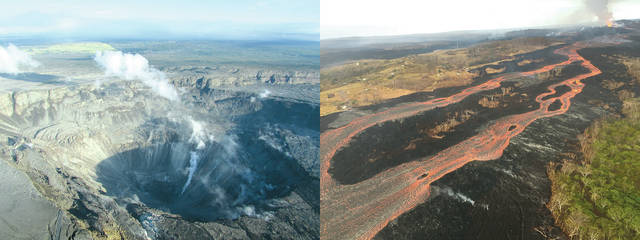The recent Kilauea eruption produced some staggering numbers, even for a volcano considered one of the world’s most active.
In just a few months, it spread as much as 1 cubic kilometer or more of molten rock over the lower Puna landscape from 24 fissures, and jolted the region with thousands of earthquakes, including Hawaii Island’s largest in 43 years, and 62 caldera collapse events at the summit. It’s perhaps no surprise that it’s considered to be Kilauea’s largest eruption on the lower East Rift Zone in at least two centuries.
But with no lava seen on the surface in more than three months, and this particular eruption likely over, what does the future hold for Kilauea and the people who call this restless mountain home?
If past experience is any indicator, the volcano could be entering a quiet period, relatively speaking.
That’s a scenario mentioned in a new U.S. Geological Survey research article published in the journal Science.
While overall the volcano remains active, the massive amount of magma erupted and the loss of a “magmatic head” due to the 6.9 magnitude earthquake that rocked Hawaii Island in May, “suggests that it may take several years before enough magma can accumulate beneath the summit to erupt,” states the article penned by Tina Neal, scientist-in-charge at USGS’ Hawaiian Volcano Observatory, and more than 50 others.
That would be a stark change from the past 35 years, when lava was erupting almost continuously along the East Rift Zone, mostly at the now-extinct Pu‘u ‘O‘o cone.
According to the article, a lull in surface activity followed the 1924 summit caldera collapse, which also may have been associated with flank instability.
Only a few small eruptions within Halema‘uma‘u crater were seen in the following decade, with a total absence of eruptions for another 18 years.
“If future activity at Kilauea follows a similar pattern, the next several years will see little, if any, significant eruptive activity,” the article says. “However, it is also possible that reduced summit magma pressure may promote higher rates of magma supply from depth due to a pressure imbalance between the deep and shallow parts of Kilauea’s magma plumbing system, which could result in renewed eruptive activity sooner than expected.”
For the time being, HVO geologists have noted that they’ve been monitoring inflation along the middle East Rift Zone — roughly between Pu‘u ‘O‘o and Highway 130 — which suggests it its refilling with magma, though there are no signs of an imminent eruption.
The recent eruption, which destroyed more than 700 homes, started May 3 in Leilani Estates about 12 miles from the summit, and continued with vigor until early August, when lava flows began to cease. Molten rock was seen rising inside fissure 8, the main volcanic vent, for another month.
While eruptions on the East Rift Zone have been common for several decades, this recent event in lower Puna produced a much higher volume and flow rate.
Approximately a quarter of the amount of lava produced during the 35-year Pu‘u ‘O‘o eruption was expelled in a matter of months.
The article says the voluminous activity was driven by several factors: a pressurized pre-eruption state at the summit and East Rift Zone, and relative low elevation of the vents.
“Past eruptions on the (East Rift Zone) have demonstrated a correlation between the magnitude of total co-eruptive summit deflation and vent elevation, with the greatest summit deflation coinciding with the lowest-elevation vents,” it states.
Additionally, the summit collapses, which occurred as magma was drained from the reservoir, also could have driven magma to the vents.
What remains unclear is why the eruption migrated from Pu‘u ‘O‘o downrift to Leilani. The article states that previous inflation events resulted in new vents nearby rather than the transport of a large amount of magma elsewhere.
“One explanation is that the initial rupturing of a barrier in the (middle East Rift Zone) allowed substantial volumes of magma to move into the (lower East Rift Zone) for the first time since 1960, and the highly pressurized state of the magmatic system probably facilitated downrift transport of magma from the summit,” it says.
Predicting the future is always a challenge, but scientists note in the paper that the recent eruption and sequence of caldera collapses, as well as how the next events unfold, provide an excellent chance to further their knowledge about Hawaii’s volcanoes.
“The next several years offer an exceptional and exciting opportunity to study the evolution of magmatism following a major perturbation to Kilauea’s plumbing system,” they write.
Email Tom Callis at tcallis@hawaiitribune-herald.com.






